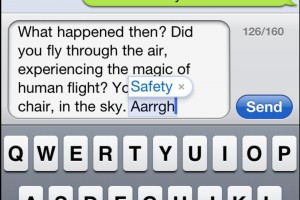Stand Up For Autocorrect

Whenever we send a text with an incorrect word in it, we are quick to blame autocorrect. “Good night” easily becomes “good might” and “Santa” is suddenly represented as another guy in red with horns and legs of a goat.
For longer texts, e-mails and important assignments or you resume, you always have the possibility to use a more advanced spellcheck to check your writing before sending it on its way to its intended destination. Quick chat messages or short e-mail replies from your phone, however, seldom to never go this way. This is where autocorrect comes into play.
After some, more or less elaborate, button smashing, we hit send—just in time to see that “jump” has become “dump”, or that your consumption of a refreshing “Coke” has become way more explicit than anticipated.
Inevitably, the frustration level rises, and (to ourselves or in a hasty typed explanatory follow-up) we blame the only evil villain we can accuse of these word crimes: autocorrect.
Stand Up For Autocorrect
If you think about it, blaming autocorrect is a very easy way out. Especially since we only speak of it when it fails us. When “kissing” suddenly becomes “killing”, we grit our teeth and growl to ourselves. Once more, autocorrect lead to an embarrassing situation. But what about all these times autocorrect helped us out?
Initially, this replace-as-you-type feature has been developed to avoid common spelling mistakes and typos. Autocorrect makes our mobile life easier and saves time we usually waste for going back and correcting our text messages. Typos are corrected, unfinished words completed, formatting applied and punctuation marks transformed into emoticons. Even accidental “shouting” via caps lock is oftentimes prevented. All of this by yours truly, the poor little autocorrect.
Autocorrect is artificial intelligence in its daily form. It makes your life easier, does its job without complaining and is even able to learn. Unknown words can be saved and thus you can create your own library of new words. Shortcuts for frequently used words spare you to type out long terms by simply choosing the correct suggestion after typing the first two letters only.
How often do you hear about these good traits of the autocorrect function though? Almost never. We take it for granted that this feature does exactly what it should and lash out at it, as soon as it shows the slightest weakness. How many times has autocorrect saved YOU from the slurs of trembling or slippery fingers (due to alcohol, the cold or any other reason)? How many times has autocorrect transformed a hasty typed-in text filled with nonsense into a cohesive message for your partner, friend, boss or parent?
It’s Not That Bad
Despite all supposed and actual flaws of the autocorrect function, you have to admit that, in the end, it is not as bad. It is still a relatively new technology, especially compared to the development of the computer or the steps the internet took since it (kinda) has been launched in 1969.
It is more than well known that, due to autocorrect, some text messages sent can be misleading and/or embarrassing, but everyone—nowadays—is aware of this. You don’t have to pull a leg to explain what happened when you accidentally send “choking” instead of “cooking”. A simple notion of autocorrect and your conversational partner gets it.
Besides, texting has become a lot more fun this way and you can’t deny that!
